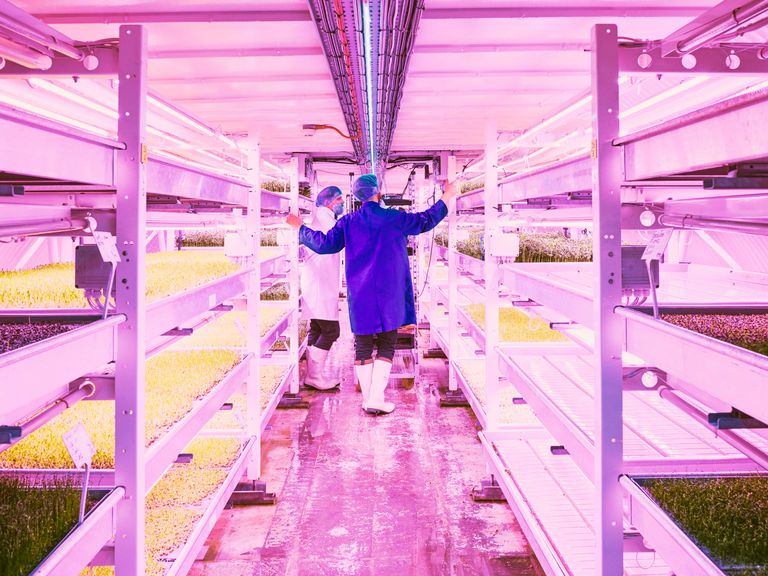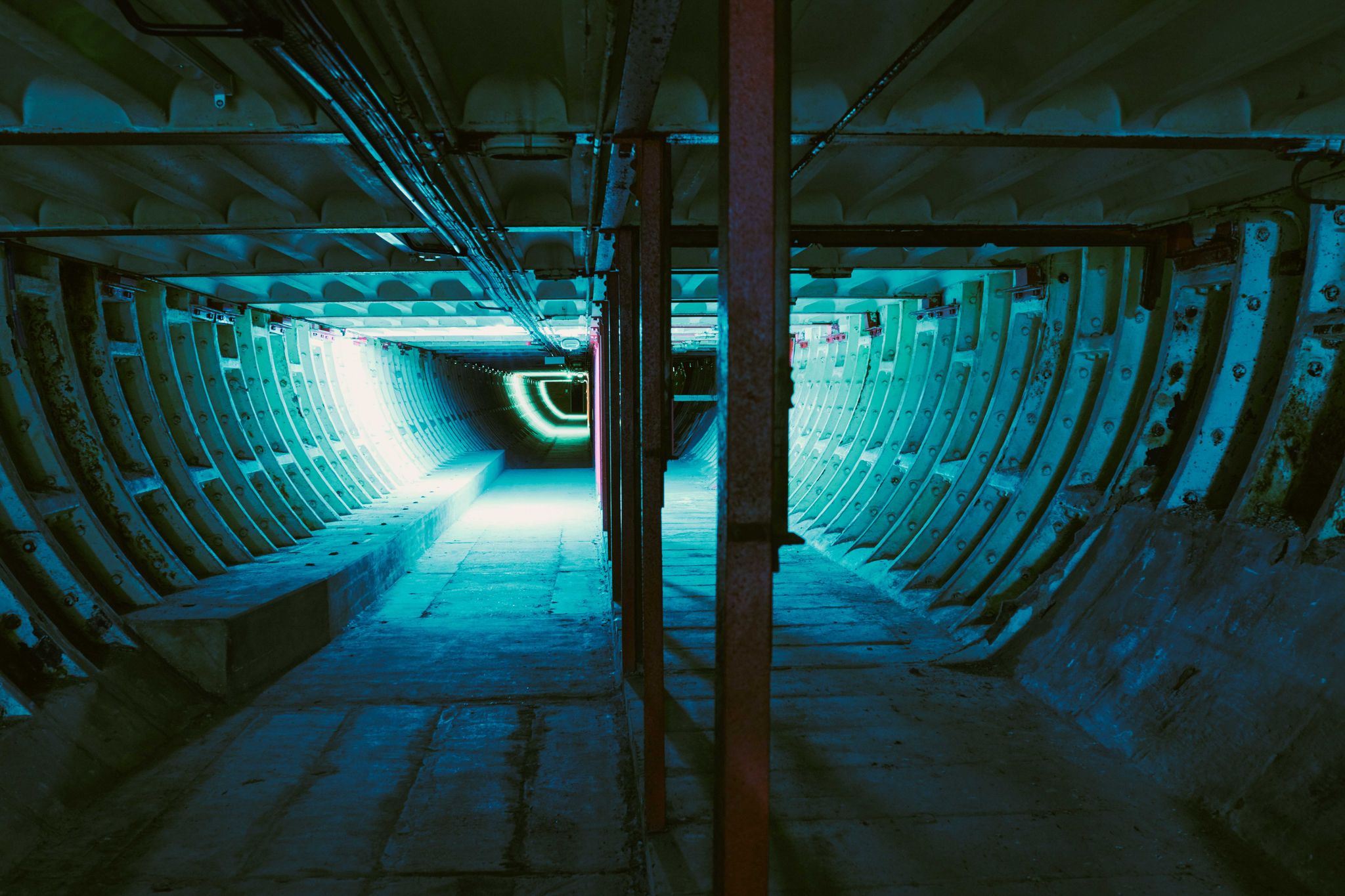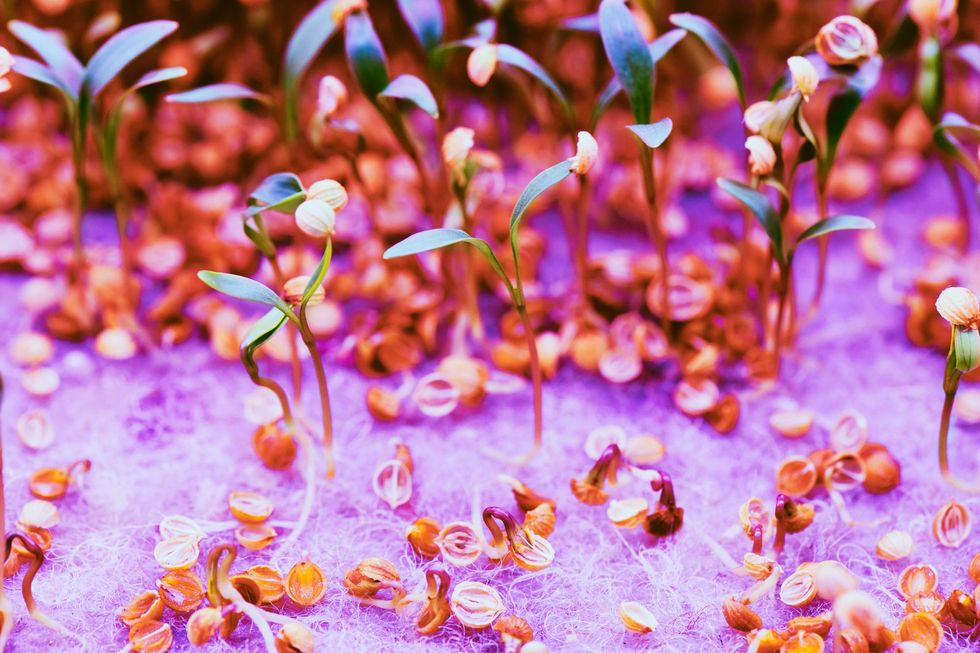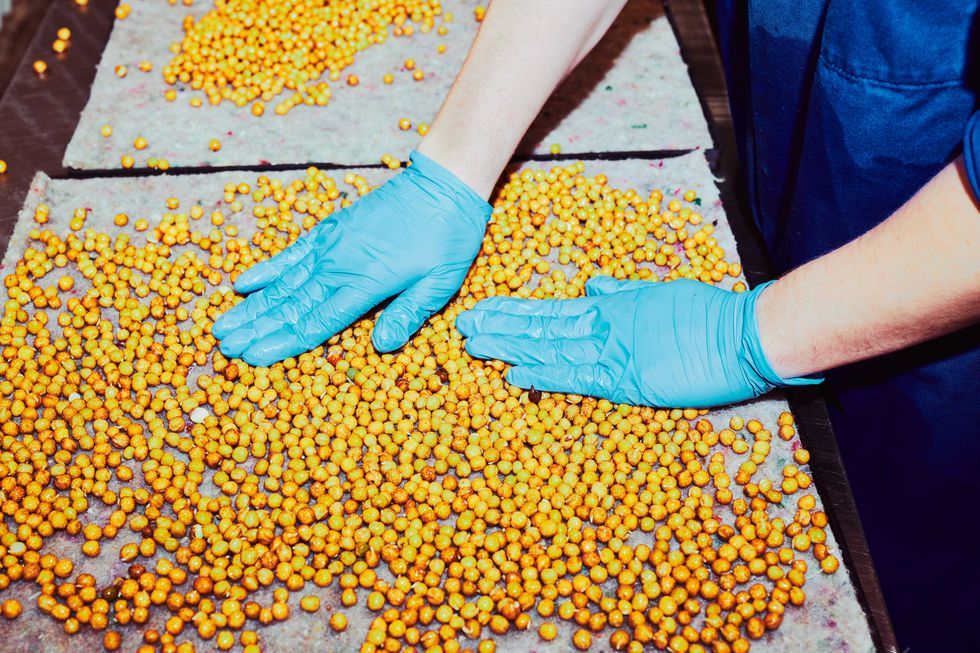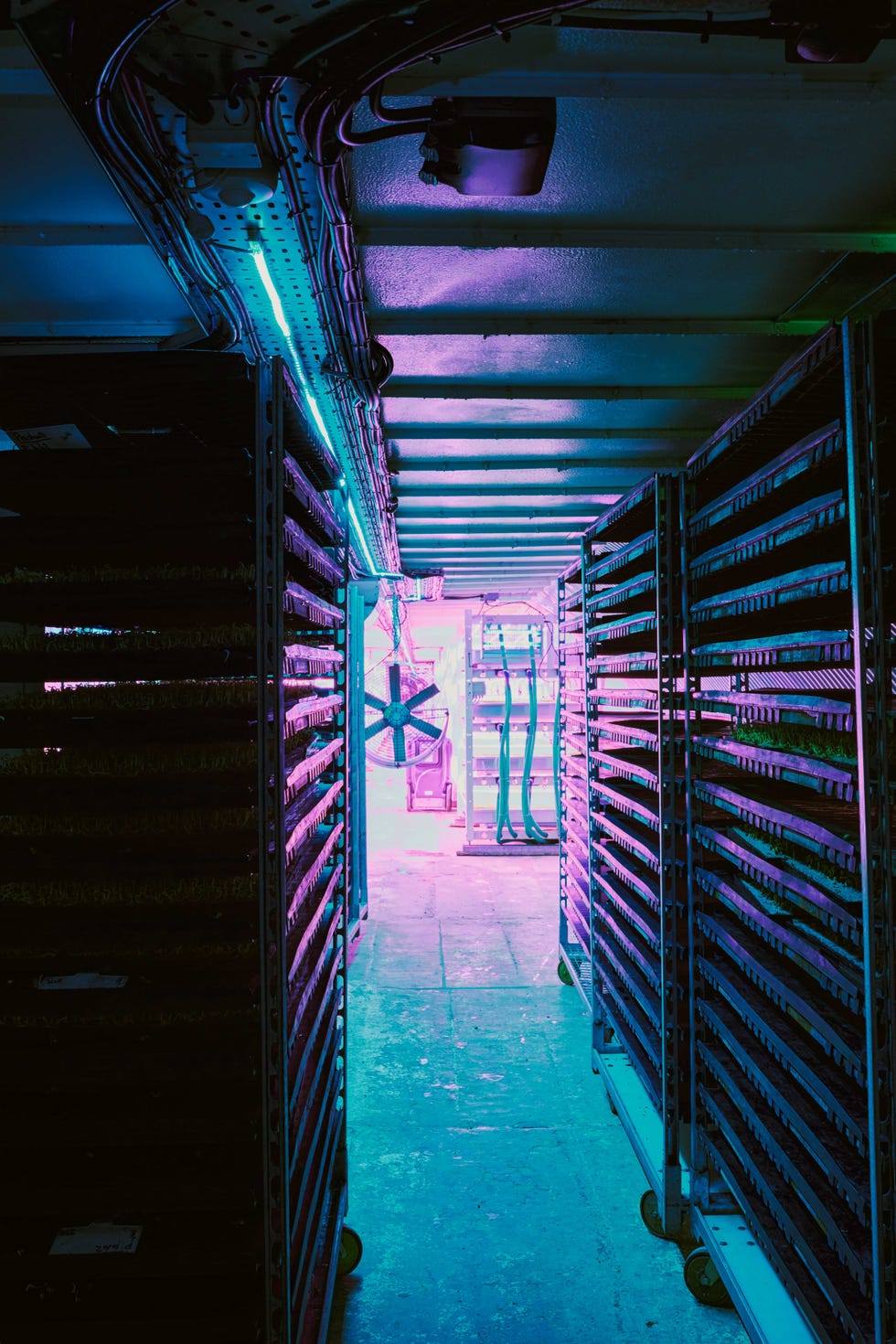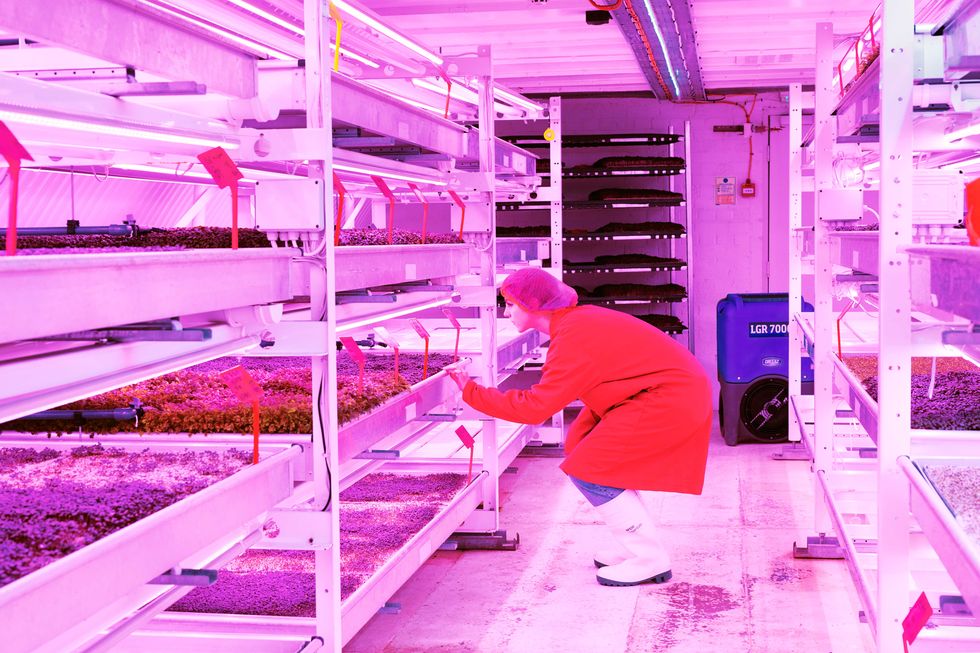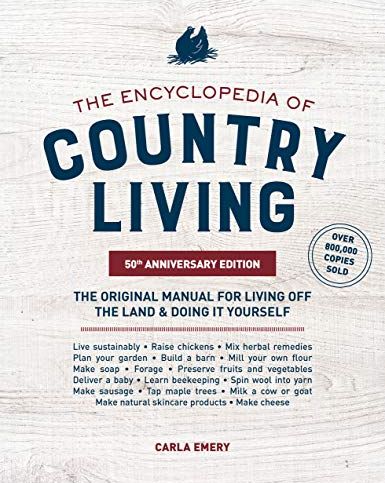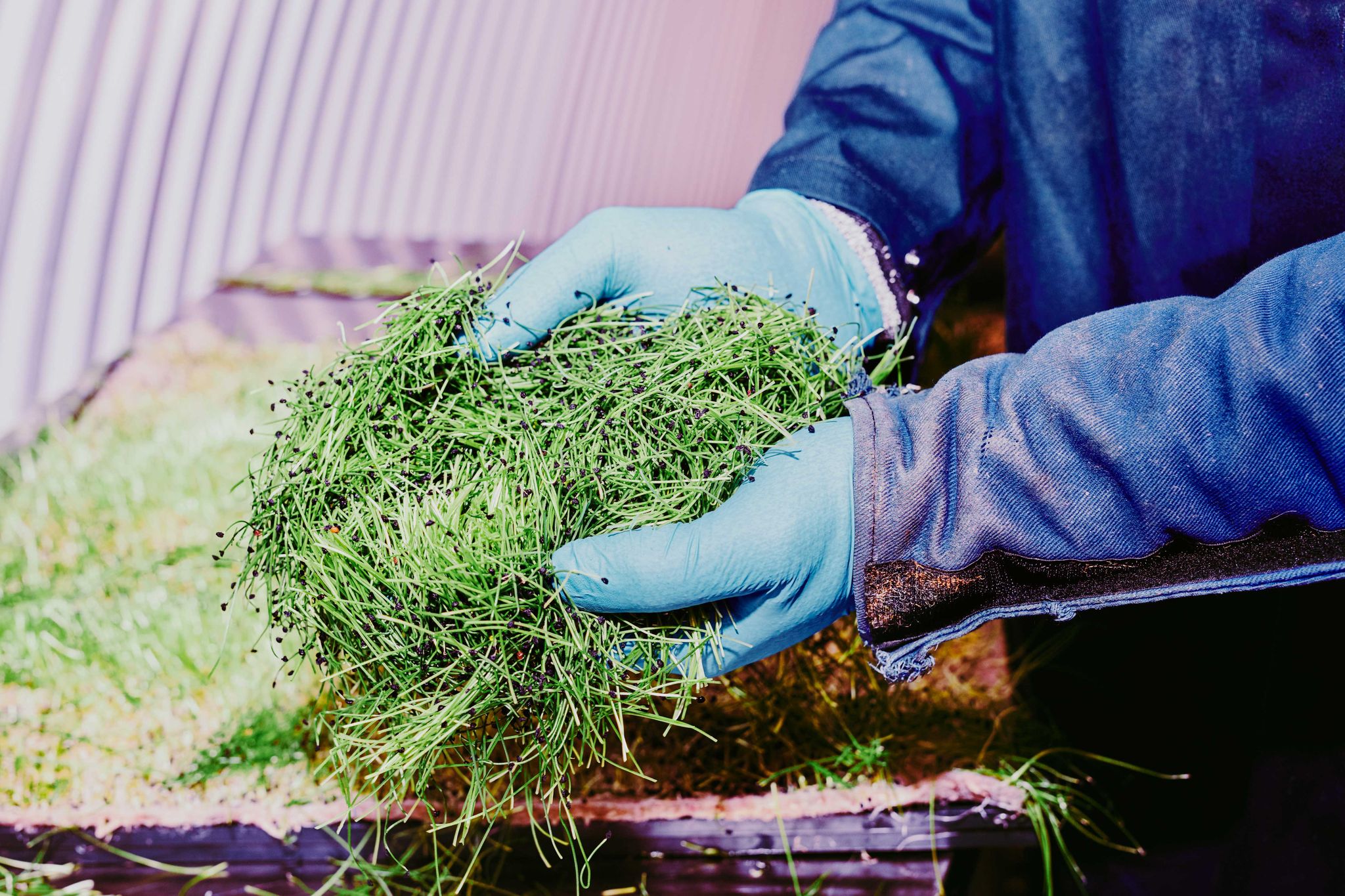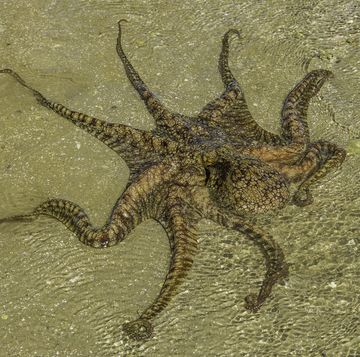Deep beneath the streets of London, in a complex of bomb shelters left abandoned since World War II, something is growing. Thousands of green sprouts burst from their hydroponic trays, stretching toward glowing pink lights that line the arched ceilings. These plants, along with tens of thousands of other salad crops, are being grown from seed without soil or sunlight, in tunnels transformed into a high-tech commercial farm.
The farm is known as Growing Underground (GU), and it’s located 108 feet below the main street in Clapham, a south London suburb. Every year, in 6,000 square feet of old bomb shelter, more than 100 tons of pea shoots, garlic chives, cilantro, broccoli, wasabi mustard, arugula, fennel, red mustard, pink stem radishes, watercress, sunflower shoots, and salad leaves are sown, grown, and prepared for dispatch.
London’s unique move toward re-localizing agriculture—feeding its growing population while cutting the environmental impact of producing and transporting crops—is the brain-child of entrepreneur Richard Ballard and his business partner Steve Dring.
“The United Nations predicts that we need 70 percent more food by 2050,” says Ballard. “But how are we going to achieve this when only 10 percent of the Earth’s surface is suitable for agriculture and we use a third of that to grow livestock feed?”
Ballard’s journey to becoming a pioneering subterranean farmer is an unusual one. After his ethical garden furniture business went bust in 2008, he moved closer to his old friend, Dring, and the pair would regularly sit in the pub and discuss ideas for start-ups. Both men were intrigued by the idea of vertical farming as an efficient way to feed people, especially in urban areas.
These farms are not susceptible to weather, and crops can be protected from food contamination and grown without herbicides and pesticides. Transport costs are minimal, harvesting is often automated, and much of the water used to grow crops can be recycled.
But the question of how to build it in a city where living space is at such a high premium presented their first major challenge.
At that time, London’s Crossrail line was in its construction stages. The excavations for the 73-mile-long high-speed railway across the city regularly featured on the TV news—especially as secrets to the city’s past were being unearthed, including plague pits, Roman artifacts, and unexploded World War II bombs. It led Ballard and Dring to consider going underground.
They worked with the management company for the city’s underground railway network, Transport for London (TfL), to find the Clapham site. “As long as we weren’t building an underground nightclub, they were happy for us to trial a small farm to see if a tunnel could work as a growing environment,” Dring says.
A crowdfunded campaign raised more than $900,000 to develop the site. After a successful trial in one small section of the shelters, Ballard and Dring negotiated a nearly 20-year lease from TfL and began operating in 2015.
The entrance to GU is within an unassuming brick office at street level. In here sit four of the site’s seven aboveground staff; they work at computers taking orders from retailers and arranging deliveries. It’s also the spot where visitors are asked to remove any jewelry and sign a consent form confirming that they are in good health, have never carried typhoid, and are not bringing any nuts onto the site.
From there, it’s a trip into a cramped elevator with barely enough room for two people. It descends slowly, 10 stories belowground, to where visitors step out into a tunnel of whitewashed corrugated arches that contrast brightly with the eerie elevator shaft. Through a row of rubber strips hanging from a tunnel entrance, the kind you see in an industrial refrigerator, a bright pink light glows. Coupled with a sound of hard-core punk music coming from another passageway, this farm has the feel of the illicit nightclub their landlords had feared.
The working farm currently occupies an eighth of its potential 45,000 square feet of growing space. The entire site is two parallel tunnels, each 1,640 feet in length. Built at the height of the Blitz between 1940 and 1942 and capable of accommodating 8,000 people, the space was already connected to electricity and the London water supply before Growing Underground moved in.
Belowground the next set of safety precautions sees visitors putting on white rubber boots, disposable hair nets, another net to cover any facial hair, and white lab coats.
“It’s a controlled environment. We don’t need pesticides but we can’t afford contamination,” says Jess Moseley, GU’s operations coordinator and tour guide. “We ask visitors to remove their jewelry to prevent any possibility of any foreign body contamination. We don’t want tiny gemstones in our salad.” Visitors wash their hands thoroughly with soap and use an alcohol-based sanitizer on them, and then are free to enter the farm.
Moseley works alongside a team of growers, all wearing the same hair net and rubber boots combo. Four of them, dressed in blue, stand in a line at polished-metal weighing scales picking bunches of harvested herbs and packing them for distribution.
“There are 16 production staff and two growers who organize the sowing,” Moseley explains, as the electronic scales beep and another box of fresh herbs is sealed and stacked. These micro greens are the intensely flavored early stages of plants that are usually harvested later in their life cycle. They’re especially popular with restaurants that serve dishes with very little on the plate. “We switched pea shoots to tendril pea shoots, which are frillier, because the chefs prefer them,” says Moseley.
Most of GU’s crops are micro herbs—there are only two larger crops, pea shoots and sunflower shoots. Most full-size produce such as carrots or bok choy could be grown here, but they take too long to grow to make them profitable. However, more research into alternative lighting spectrums may make these a possibility, says GU operations manager Alex Hamilton-Jones.
“Larger crops require a change to the growing equipment, like the height of the stacks and light intensity,” Moseley says. “This is going to be a part of the next iteration of the farm.”
Within its short existence, Growing Underground’s team has expanded its variety and reduced turnaround time on crops. That’s due in no small part to a number of technological innovations that optimize growing conditions on the farm.
“Our pea shoots can be harvested up to 60 times in a year,” Ballard says. “Outdoors you get three or four harvests of those in a year; in a greenhouse, around 30.”
To help plants grow quickly, the correct lights are key. Ballard and Dring tried seven different LEDs during their R&D and found that the system they settled on—spectrum AP673L LEDs from Valoya of Finland—produced the best yield and greatest flavors.
These LEDS utilize a red:far-red (R:Fr) spectrum ratio that targets the red and far-red light absorbing photoreceptors on the plant leaf. The light resembles sunlight at its peak level, which delays flowering of herbs and allows the plant to focus its energy into fast biomass development.
The result is a compact, intensely flavored product grown in a short time in conditions that not only suit the plant but meet the needs of the growers, too. “The cycle for growing coriander has gone from 21 to 14 days,” explains Riley Anderson, the site’s team leader. “Some plants can be harvested after just six days in the growing tunnel, which beats anything a farm aboveground can achieve consistently through the year.” They toyed with duller tones than the vivid pink that now illuminates the growing tunnel, but found that the reduction in visibility meant having to lift each plant tray out off of its bench to do quality checks. It slowed the process and didn’t enhance the crop.
“We wanted to source the lowest energy consuming lighting system we could find,” explains Ballard. “The LEDs do not use the same amount of energy nor do they create the high direct heat that conventional (high-pressure sodium) lights do, which means we’re able to grow the plants in shelves closer together.”
The power comes from Good Energy, which only uses renewable sources. “As it’s a closed-loop system of farming, anything that’s added—nutrients or fertilizers—stays within the circuit,” says Ballard. The only farm waste—the substrate recycled carpet left over from harvesting the herbs—is sent to SELCHP, a waste-to-energy converter in southeast London. “Zero carbon output has been the Key Performance Indicator we chose to work to from the very start because any business starting today needs to think about its impact on the environment,” says Ballard.
In addition to high-tech lighting, there are several other adaptations that allow plants in the tunnels to grow so quickly. It starts when the seeds are sown, without the aid of conventional soil: Workers place two-inch-thick rectangular growing mats—called Growfelt and made from pulped floor carpet—into shallow trays. The mats are sprinkled with seeds by hand.
Once sown, the seed trays are stacked onto carts and left in a dark section of the same tunnel for propagation. For a short time they sit in complete darkness, covered with plastic wrap. This “fools” the seeds into thinking they’re beneath the earth. This is where germination begins. Within a day or two, the seed shoots appear. By the fourth day the trays are transferred to shelves known as benches under the banks of LEDs in the crop-growing tunnel.
There’s no music playing in the growing area—workers seldom spend much time in here, as the plants are doing all the work on their own. Instead the only noise in this long, flamingo-pink chamber is the whirring of the axial fans dangling from the ceiling. Although the fans help keep the farm at a settled temperature of around 59°F, the plants beneath the glare of the LEDs feel a warmth of up to 77°F.
“There’s a slight variance throughout the farm,” says Anderson. “We place the crops strategically to optimize growth. Our radishes prefer to be right at the front of the farm, where it is coolest. Our most robust crop, the pea shoot, grows well wherever it is positioned within the farm.”
On either side of the tunnel are trays bristling with herbs at different stages of growth. In each tray a handwritten sign identifies the type of crop, along with a P date of propagation, an L for the day it was put under the lights (when transferred to the farm from propagation), and B for the bench the tray is assigned to.
The warming glow provides “sunlight” for 18 hours a day. Rain comes in the form of hydroponics. A faucet fills each tray of plants with a water-and-nutrient mix five times a day. The roots in the trays grow down through the matting to absorb the mix and then water is filtered through tanks beneath the benches. “We use 70 percent less water than conventional field farming,” says Moseley.
The night before a harvest, workers put the plants on carts in the middle of the farm, which has the best airflow, Anderson says. That dries them overnight to the point of being packable without them breaking down quicker.
To harvest, fresh herbs are sliced from their roots, shaken off of the matting that served as their soil bed, and placed into a blue bowl. From there the crop is weighed and packed into transparent tubs made from rPET—recycled plastic—and labeled with the GU logo and contents.
Above each growing bench is a round, yellow sensor the size of a large coin that records temperature, humidity, and illumination, and sends the data to the University of Cambridge’s engineering department. The results are fed back to GU, which compares them with the crop yields to determine which conditions are working best for growth.
“We monitor yields every day when we cut,” says Ballard. “A platform with machine learning capability collects the data from all the sensors and alerts you to any anomalies. It gives us access to the sort of technology being used in big agricultural projects, but that would be too expensive for us to put together.”
Crops here can be harvested, packed, delivered, and served on a plate all within four hours. The reduced time spent in transit means GU products have a longer shelf life than those grown outside of the capital. As a result they’re sold in some of the U.K.’s major food retailers and wholesalers.
A number of renowned London chefs use GU produce, too, including Michelin-starred Michel Roux Jr. He not only uses their herbs in his dishes at Le Gavroche, a French restaurant in the Mayfair area of London, but he also came on board as a founding supporter. He describes the shoots and leaves that it provides as “mind-blowingly good.”
For distribution to smaller restaurants, GU goes underground as well. “We send our delivery guys off with all these bags of orders onto the subway trains,” says Anderson. “Food that’s been grown in a Tube tunnel is delivered through one as well, further reducing the carbon footprint.”
Tours of the tunnels take place outside of the production cycle, with chefs, students, and potential investors visiting during the week and members of the public shown around on Saturday afternoons. “We’ve had farmers from Scotland, mainland Europe, and as far as America come and visit us,” adds Anderson. In the past five years that the farm has been operating, technology has improved a lot—more efficient LED lighting, water recycling, and air management systems, Anderson says. “But the principle of what we’re doing is remarkably simple, giving crops the nutrients they need and a medium to grow in.”
Ballard is now busy sourcing funding to expand farther into the tunnels while investigating sites for other controlled-environment farms in other parts of the world and in different structures.
“When we started, the plan was to produce a supply for London,” Ballard says. “But as the retailers have taken an interest, we’re now looking to serve their distribution centers beyond the M25 [London’s encircling motorway].”
As GU grows, it looks to similar farms for inspiration. In South Korea, subterranean vegetable farms are cropping up at underground stations on the Seoul metro, thanks to a start-up called Farm8, while in Tokyo, abandoned utility tunnels built to service a skyscraper city that never materialized have also been converted into GU-style farms. In Hamburg, Germany, a vertical farm called &ever uses methods similar to GU’s to harvest salad crop using just 5,920 square feet of indoor growing space. Producing an equivalent yield outdoors would require 161,458 square feet of open field.
Increasingly crowded cities are getting imaginative when it comes to farmland. “But these farms don’t have to be underground at all,” says Ballard. “It can be in an abandoned factory or disused warehouse aboveground. The model is simply redundant space.” Even so, with at least six more abandoned tunnels beneath London alone, GU’s subterranean farm may not be the only game of its type in town, or underneath it, for much longer.
